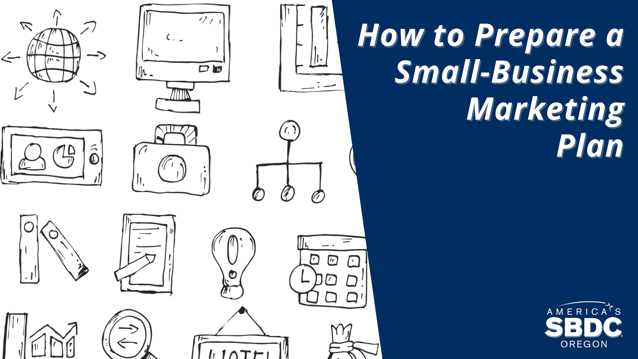
First published by the Oregon SBDC Network here.
What a SWOT Analysis Is, and How to Best Utilize It When Creating Your Marketing Strategy
One of the most valuable tools for Oregon entrepreneurs is a comprehensive small-business marketing plan. Why is it so critical to your success? Because without potential customers having awareness of your offerings, even the best product or best service will languish.
An effective small business marketing plan is not about having a big marketing budget—it’s about determining the right marketing strategies for your business, understanding your competitive advantages, and developing tactics to support your visibility and marketing goals.
In this guide, we’ll share some tips on preparing your small-business marketing plan, including how to:
- Evaluate your business by creating a SWOT analysis
- Determine your small-business marketing budget
- Identify the target audience for your small business
- Set marketing goals and build your marketing strategies
- Finalize your small-business marketing plan
Evaluate Your Business by Creating a SWOT Analysis
The first step to creating a small-business marketing plan is to understand where your business stands. An honest assessment of internal and external factors will help you put together a strategic direction for your business.
One way to begin is by creating a SWOT analysis, which stands for Strengths, Weaknesses, Opportunities, and Threats.
For Strengths, consider what your business does well. What qualities separate you from others in your industry? What internal resources do you have that serve as an advantage? What tangible assets do you have, such as intellectual property, capital, or proprietary technologies?
Under Weaknesses, write down what challenges you have, whether they are something your company lacks, limitations in resources, or advantages your competitors have over you.
Identify Opportunities for your business, such as underserved markets for your products or services, favorable market trends for your products or services, and other external factors that may have a positive impact on your business and industry.
For Threats, take a look at what factors can negatively impact your business and industry, such as emerging competitors, changes to laws and regulations, and changes to customer sentiment.
Generally speaking, strengths and weaknesses should speak to internal circumstances, and opportunities and threats will focus on external factors that affect your small business.
Determine Your Small-Business Marketing Budget
Marketing costs money, so once you have a clear understanding of the circumstances of your small business from creating a SWOT analysis, it’s time to set a budget for your marketing plan.
As you begin to determine your marketing budget, be realistic about what you should invest. If you own a new business that is working to establish itself, you might consider allocating a higher percentage of your gross revenue as compared with an established business.
In addition to setting a monetary budget, consider the amount of time you plan to spend marketing your business each week. Oftentimes, busy entrepreneurs put their marketing efforts on the back burner as they get bogged down by day-to-day tasks. It’s crucial to apply enough time and resources in this area to move the needle for your business.
If marketing is not your forte and you don’t have time to focus on executing marketing strategies on your own (or don’t have a dedicated staff member to help you), your budget might include hiring specialists to assist with your marketing efforts.
Identify the Target Audience for Your Small Business
With your SWOT analysis complete and a marketing budget in mind, the next step in how to prepare your small-business marketing plan is to identify who you will target through your marketing efforts.
A small business’s target market is determined by many factors. You can consider specific demographics such as:
- Geographic location
- Business type
- Gender
- Income level
- Marital or family status
You can also consider the psychographics of your target audience, which include:
- Values
- Interests and hobbies
- Lifestyles
- Behaviors
When you know who your target is, you can then determine which channels you will focus your marketing strategy on.
Set Marketing Goals and Determine Your Marketing Strategies
You’ve conducted a SWOT analysis. You know who your ideal customers are. Now it’s time to determine how you’ll reach them and set some benchmarks.
Some common examples of marketing goals include:
- Increasing website traffic
- Generating leads
- Increasing social media followers
- Growing an email list
- Improving conversion rates
While setting specific goals is a vital aspect of the strategic planning process, it’s just as important to break down each objective into small, actionable steps to help you reach your goals.
Many small-business owners implement the SMART method (Specific, Measurable, Attainable, Relevant, Time-based), which can clarify each goal, focus your efforts, and efficiently allocate time and resources.
Consider these questions as you create your goals:
- What is the goal? Be Specific.
- How can my progress be Measured?
- Do I have the skills and resources for this goal to be Attainable?
- Why is this goal Relevant to my business needs?
- What is the Timeframe for achieving this goal?
Once you have your goals in place, you can determine the best channels and marketing tactics to reach your target audience and make progress toward reaching your goal.
Here’s an example of a SMART goal, and some marketing tactics that can be employed:
Goal:
Increase unique website visitors by 10% in 2022.
Marketing Tactics:
- Create a search engine optimization (SEO) strategy.
- Create a pay-per-click (PPC) campaign to drive new users to your website.
- Implement a social media advertising campaign to create awareness and increase traffic.
- Review progress on a monthly basis.
- Finalize Your Small-Business Marketing Plan
The final task in the planning process of your small-business marketing plan is to prioritize the tasks you want to accomplish. Having a to-do list to reference takes the guesswork out of deploying your marketing initiatives while running your business.
As you finalize your plan, you may wish to have a mentor review your small-business marketing plan, particularly if you are a new business owner. The PCC SBDC Network offers no-cost, confidential advising services in all areas of business to help Oregon entrepreneurs succeed.
For established businesses that anticipate growth, the network’s Market Research Institute provides customized, data-based reports to help business owners build a customized marketing plan based on their needs and goals at no direct cost.
Want More Advice?
The PCC Small Business Development Center is here to support you with no-cost business advising and comprehensive business training programs. Get started by requesting your first no-cost business advising session here.



